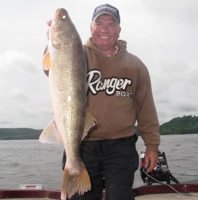Cross Current Tactics Catch Huge Walleyes
Category: article
Jan 31st, 2011 by OutdoorsFIRST
Modified Jan 31st, 2011 at 12:00 AM
Conventional wisdom regarding locating walleyes on river systems focuses primarily on current seams and breaks. The sweet spot is generally on the edge, where fast water meets quiet water. These current breaks allow fish to position in slower moving water but allow an opportunity for fish to dart out into the fast water as forage tumbles by. Traditional tactics include slipping the current with three way rigs, rigs and jigs downstream or crawling upstream with crankbaits, jigs and three way rigs.
 |
|
|
|
Some of the best river rats however are adding a new wrinkle to the presentation that is putting a lot more fish in the boat. Anglers have often found fish in the faster water which often coincides with the main channel. Sauger in particular seem to handle much faster water but there are several circumstances where walleyes will use the fast water as well, particularly when fish are making big moves through a system which is typical during the spring. What anglers are beginning to understand is the concept that there are pockets of quiet water that exist within the tumble and flow of some of the fastest water much like the boil you can physically see on the surface of fast water. These boils provide relief as fish move up and down through this faster water. Anglers have long recognized the potential of this faster water and have traditionally used hand lines, lead core or three way rigs in conjunction with crankbaits or stick baits to slowly crawl upstream or in some cases slip down stream.
One of the most popular presentations for this described situation is a heavy three way rig that is fished nearly vertical below the boat in conjunction with a floating minnow imitating lure like an original floating Rapala or Flat Rap. This combination in particular has caught a tremendous number of both walleye and sauger on river systems across the Country. This tactic however has continued to be refined in recent years. Anglers have long realized the effectiveness of holding momentarily in position over sweet spots and just letting the current work the lure in place.
One of the hottest tactics that is working on so many rivers right now however is to move the boat and presentation cross current in an attempt to swing the lure back and forth in a tight position instead of the traditional tactic of crawling up or down stream. By powering back and forth cross current, the fish seem to get a longer window to strike the lure and the boat can work a tighter area while moving with the current. Most anglers are using a kicker motor in conjunction with a bow mount trolling motor like the Minn Kota i-Pilot, using the bow mount to hold in the current, swinging the transom back and forth with the kicker in gear. This cross current pattern is deadly effective and is often much more productive than crawling with or against the current, once tight pods of fish have been located.
The weight on the bottom of the three way is often heavy enough to cut through the current and keep the presentation below the boat which aids with working the rig through snags and mussels and boat control is aided because the presentation is close to the cone angle of the transducer located near the transom of the boat. With this type of presentation, floating Rapalas have probably accounted for more walleyes than any other lure but another deadly tactic that can pull fish out of spots combines the new soft plastics with three way rigs. I often experiment with the soft plastic fluke and minnow tails, rigging them on a plain, snell hook.
To rig these plastics where they seem most effective, hook the fluke or minnow right through the nose so that the bait can flop and shimmy on the hook when lowered into the current. The most effective soft plastic I have ever used particularly when the water is still colder than fifty five degrees is the Trigger X that has gotten so popular with walleye anglers over the past year. This “do nothing” rig is more subtle than traditional crank bait and minnow bait presentations but can really be the ticket some days… particularly real early in the season when the water can still be clear before run off begins to stain and muddy the water.
Editors Note: The author, Eric Olson is regarded as one of the most consistent anglers on the FLW Walleye Tour with several top ten finishes, recently winning the Lake Oahe event in 2010.